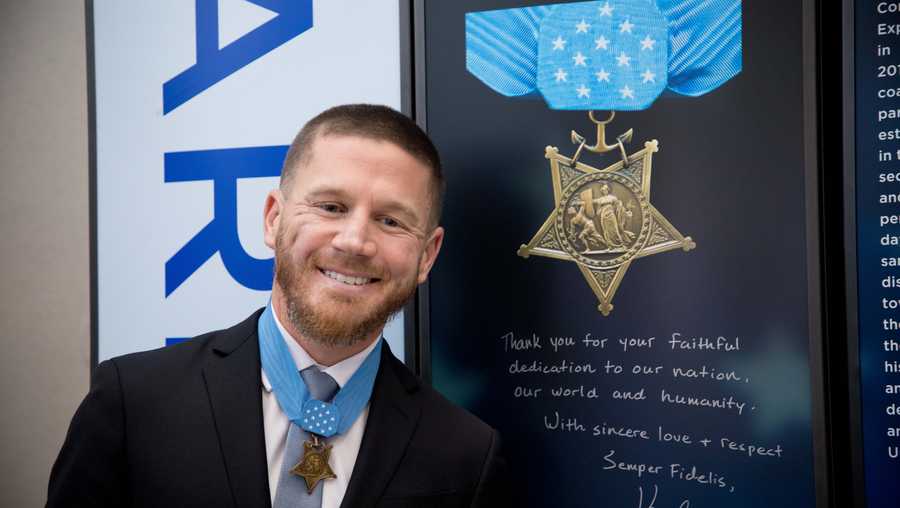

A supercomputer run by the Army is now named after a Marine recipient of the Medal of Honor.
“Carpenter” is an HPE EX 4000 at an army computing lab in Vicksburg, Mississippi. The supercomputer has 277,248 core, 563 terabytes of memory and, as of Tuesday, one Medal of Honor recipient — Corporal Kyle Carpenter — as its namesake.
Carpenter was a Lance Corporal in 2010 in Marjah, Helmand Province, Afghanistan. During a Taliban attack, a grenade landed in the observation post Carpenter was manning with another Marine. Carpenter jumped at the grenade, shielding his comrade from the blast. Carpenter was gravely wounded but survived and received the Medal of Honor in 2014 for his actions.
“I know you all will be very surprised that Marines do not usually spend a lot of time around advanced computing systems,” Carpenter joked at the computer’s ribbon cutting ceremony December 12 at U.S. Army Engineer Research and Development Center. “Being a kid who thought it couldn’t get any better than a Nintendo 64, its incredible to see how far we as humans have come in our pursuit of knowledge and technology.”
Located in Vicksburg, Mississippi, the machine is the third supercomputer at the Army’s ERDC computing center to be named after a Medal of Honor recipient originally from the state. Carpenter is from Flowood, Mississippi. Other machines at the Army lab are named for two Medal of Honor recipients from Vietnam: Lance Corporal Roy Wheat, who threw himself on an exploding mine to save fellow Marines; and Army Captain Ed Freeman, a helicopter pilot who flew daring supply and rescue missions during a fierce firefight.
Housed at the ERDC’s Information Technology Laboratory, the EX 4000 is made up of several soda-machine sized cabinets that are normally grey or black, but Carpenter’s image is now stretched across it, next to pictures of the Medal and a U.S. flag.
“I thought I was going to look out and see just a blank computer with nothing on it, and then I looked through that window, and I saw myself,” Carpenter said. “But really, I saw our military and our nation and so many that have given so much and ultimately a moment for all of us, but for those that never made it home as well.”

Along with jokes about Marines and computing power in a speech at a ceremony to officially name the system, Carpenter said the giant computer was a symbol of the many ways that Army scientists work in labs directly protects
Carpenter — the computer — has been clocked at 9 “petaflops,” or 9 quadrillion individual computations in a second. To count to a quadrillion, you would have to count to a million then start over one million times. And then do all of that 1000 times.
That speed would make Carpenter close to the 80th fastest computer on earth, according to Top500.org, which tracks supercompturs, roughly as fast as the Aitkin computer at the NASA/Ames Research Center which is used to model lunar missions, and a system called Taiwania 2 in Taiwan. The fastest supercomputer is Frontier at the Department of Energy’s Oak Ridge National Laboratory which can hypothetically reach speeds of 1,600 petaflops.
So how fast is a 9 petaflops? It means that Carpenter’s circuits can run close to 5,000 times more computations per second than an iPhone 14 Pro and 750 times faster than an XBox Series X.
Carpenter, the Marine, has 458,000 followers on his instagram, ChicksDigScars.
The computers at ERDC are designed to simulate how complex weapons systems work, like explosives and rockets. Rather than build and destroy multiple prototypes, the computers simulate how they are likely to work in various conditions and against various targets.
“With the addition of the Carpenter supercomputer, ERDC will continue to do its part to ensure DoD has what it needs to lead the world in supercomputing solutions,” said Dr. David Pittman, ERDC director. “You and your fellow Marines, Soldiers, Airmen and Sailors are the reason we come to work every day.”
The latest on Task & Purpose
- First female active-duty soldier graduates from sniper school
- 5 question only a veteran would ask Medal of Honor recipient Michael Thornton
- Navy fires recruiting district commanding officer
- Army tanker vet facing cancer gets a final wish: send one last round
- Army employee indicted for stealing $100 million from military youth program
